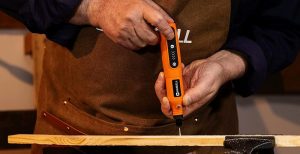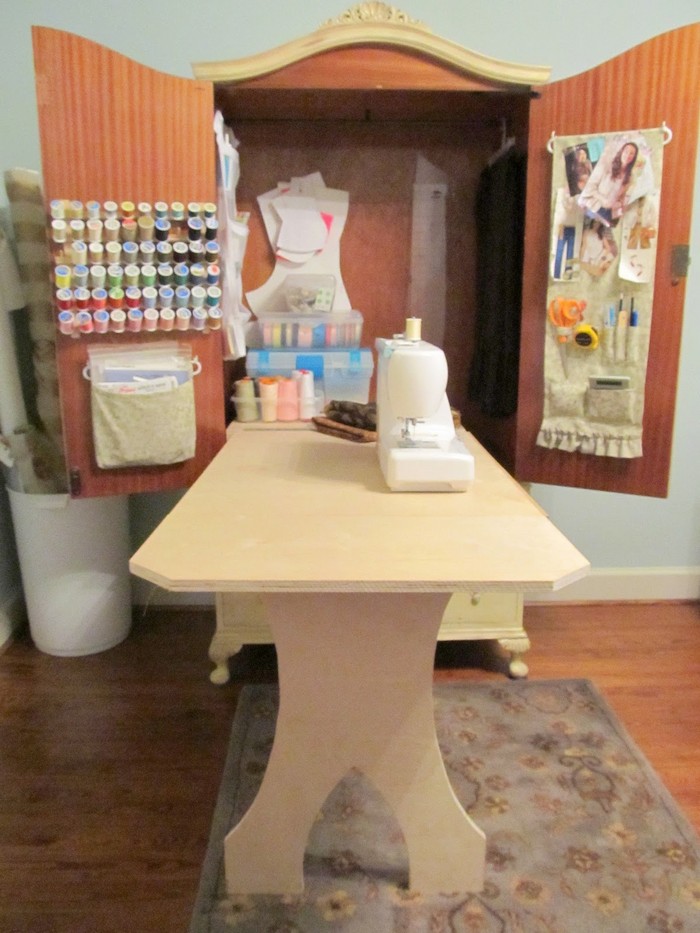
A French armoire is a tall, freestanding cabinet used for storing clothes and other items. Armoires are typically made of wood and often feature ornate carvings and detailing. In France, armoires were traditionally used in bedroom settings, as they were large enough to hold all of a person’s clothes.
Today, French armoires are still popular bedroom furniture pieces, but can also be used in other rooms of the home, such as the living room or office. And if you are about to get rid of yours, think again and upcycle them into something useful.
Regularly working on different sewing projects but don’t have a dedicated work area? Then your sewing machine and other materials might be on your dining table until you finish your project. Or any place they are not supposed to be for that matter.

If you’re looking for ways to improve your sewing setup at home, why not consider transforming an old French armoire into a sewing cabinet? This is a great way to have your dedicated sewing space that can be easily put away when not in use.
Plus, it adds a touch of charm and sophistication to your home sewing area!
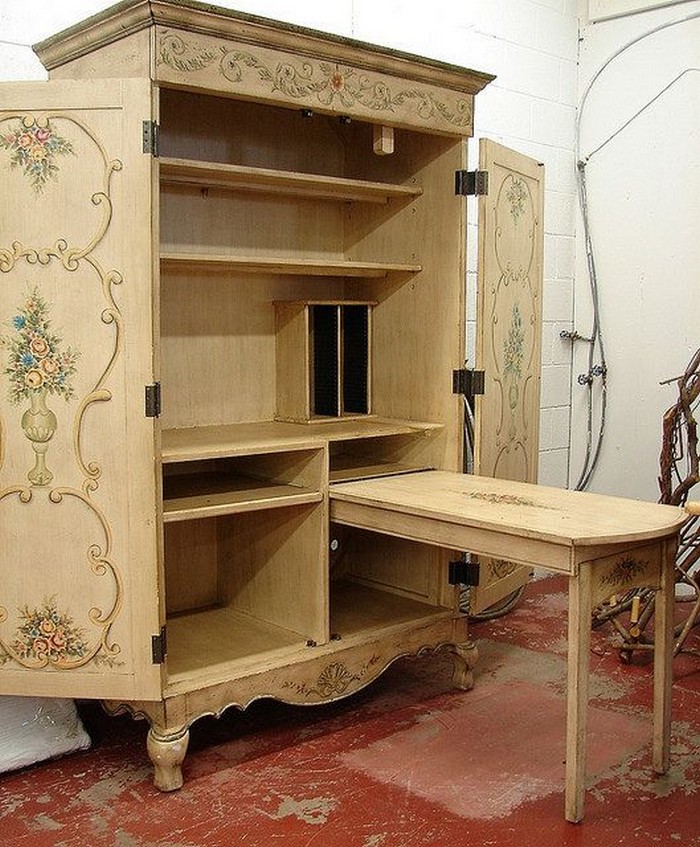
This French armoire sewing cabinet is a clever storage solution for crafty people without a dedicated craft room. It’s a great way to make use of an otherwise unused piece of furniture, and it provides a convenient place to store all of your sewing materials.
This French armoire sewing cabinet is a great option for people who don’t have a lot of space for a dedicated craft room, and it’s a great way to keep your sewing supplies organized and within easy reach.
When upcycling your French armoire, it is important to take into account the different sizes that these pieces of furniture come in. This will ensure that you can properly utilize the armoire in your home.
The first thing you need to do when upcycling your French armoire is to take accurate measurements of the piece. Once you have these measurements, you can begin to look for ways to incorporate the armoire into a sewing cabinet.
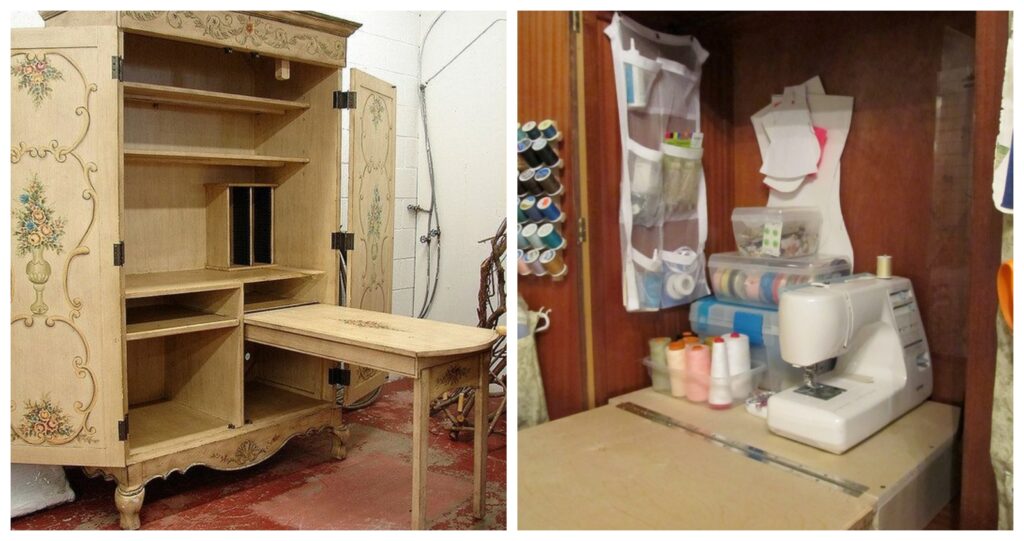
The sewing cabinet that you will be working on will need a craft table; for this, you can consider a fold-away sewing table. When picking out a fold-away sewing table, be sure to take measurements of your French armoire to ensure it will fit comfortably inside when not in use. This will give you the extra space you need to store your sewing materials and other supplies, as well as give you a sturdy surface to work on.
Adding diagonal shelves to the doors of your French armoire is a great way to store threads and fabrics for your sewing projects. This will allow you to keep the fabrics you need close at hand, making it easy to access them when you need them. This is a great way to organize your sewing supplies and ensure that everything you need is within easy reach.
And of course, make a space for your sewing machine because this sewing cabinet will not be complete with it. Make sure to measure your sewing machine and allocate enough space for it in the cabinet. This will ensure that your sewing cabinet is both functional and stylish.
Is this the French armoire sewing cabinet you are looking for?
Contents
How to Make a French Armoire Sewing Cabinet
You’ll need these materials:
- French Armoire
- Birch Plywood
- Piano Hinges
- Drop Leaf Table Hardware
- Hooks
- Wood Screws
And these tools:
- Measuring Tape
- Saw
- Cordless Drill
Click on any image to start the lightbox display. Use your Esc key to close the lightbox. ![]()
Steps:
Creating a French armoire sewing cabinet using a French armoire as the base requires careful planning and execution. Here’s a step-by-step guide to help you through the process:
1. Preparation and Planning:
- Measure the dimensions of the French armoire to determine the available space for the sewing cabinet.
- Sketch out your desired layout for the French armoire sewing cabinet, including the placement of the drop leaf table, sewing machine, storage compartments, and accessories.
- Gather all the necessary materials, including birch plywood for constructing shelves and compartments, piano hinges for attaching the drop leaf table, hooks for hanging tools and supplies, and wood screws for assembly.
2. Disassembly (if necessary)
- If the French armoire has existing shelves, drawers, or doors that need to be removed to accommodate the sewing cabinet, carefully disassemble them using appropriate tools.
- Set aside any hardware or components that you may want to reuse or repurpose later.
3. Construction of Shelves and Compartments:
- Cut the birch plywood to the desired dimensions for constructing shelves, drawers, and compartments within the armoire.
- Use a combination of screws, glue, and dowels to assemble the shelves and compartments securely.
- Ensure that the shelves and compartments are sized appropriately to accommodate your sewing machine, supplies, and accessories.
4. Installation of Drop Leaf Table:
- Attach piano hinges to one side of the drop leaf table and the corresponding side of the armoire.
- Secure the hinges in place using screws, ensuring that the drop leaf table opens and closes smoothly.
- Test the stability and weight-bearing capacity of the drop leaf table to ensure it can support the weight of your sewing machine.
5. Mounting Hooks and Hardware:
- Install hooks on the interior walls or doors of the armoire to hang tools, scissors, thread spools, and other sewing supplies.
- Use wood screws to securely attach the hooks, ensuring they can withstand the weight of the items they will hold.
6. Finishing Touches:
- Sand any rough edges or surfaces of the birch plywood shelves and compartments to ensure a smooth finish.
- Apply a coat of paint or wood stain to match the aesthetic of the French armoire or your personal preference.
- Reassemble any remaining components of the French armoire, such as doors or decorative trim, if desired.
7. Organization and Decoration:
- Arrange your sewing machine, supplies, and accessories within the newly constructed French armoire sewing cabinet.
- Add decorative touches such as fabric lining, labels, or embellishments to personalize the cabinet and make it functional and visually appealing.
By following these steps and using high-quality materials and hardware, you can transform a French armoire into a stylish and functional sewing cabinet that adds charm and utility to your workspace.
Thank you to Cottage Hill for sharing strategies on how to make a French armoire sewing cabinet.
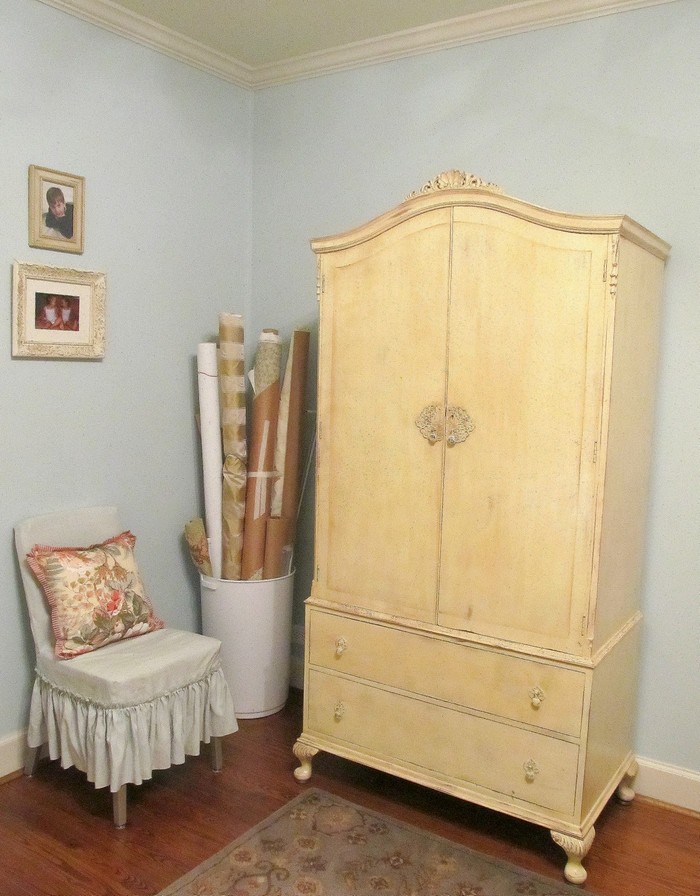
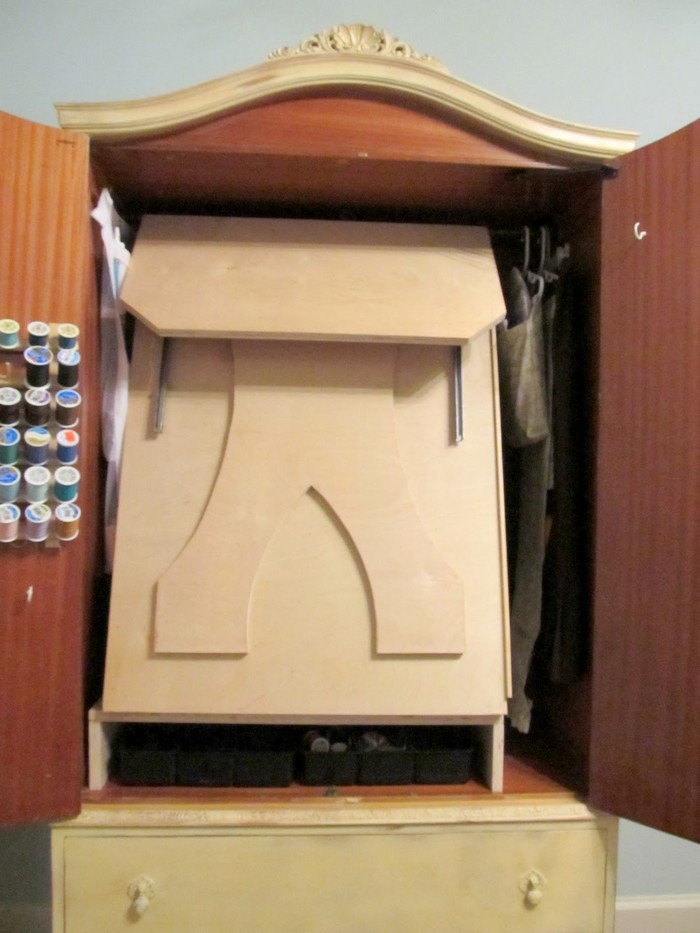
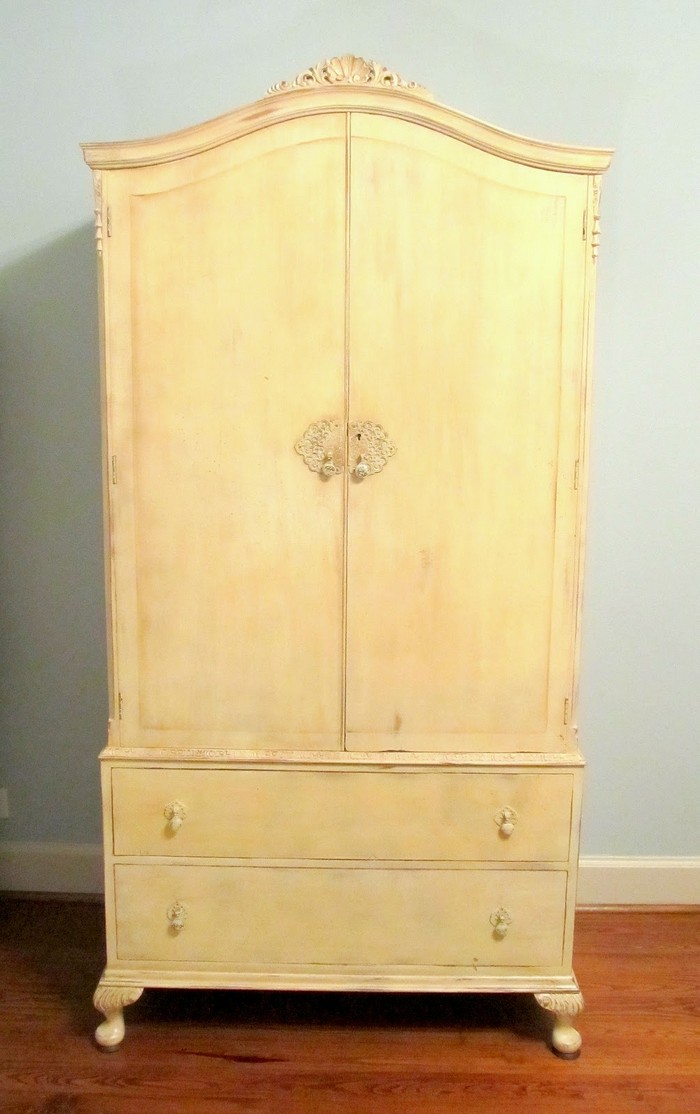
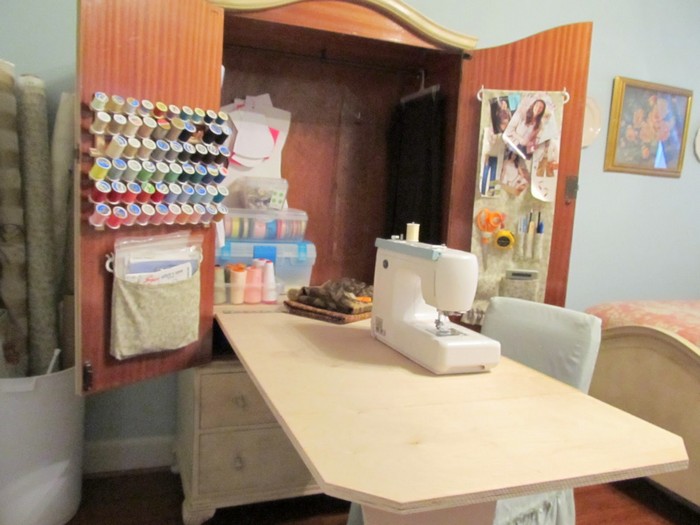
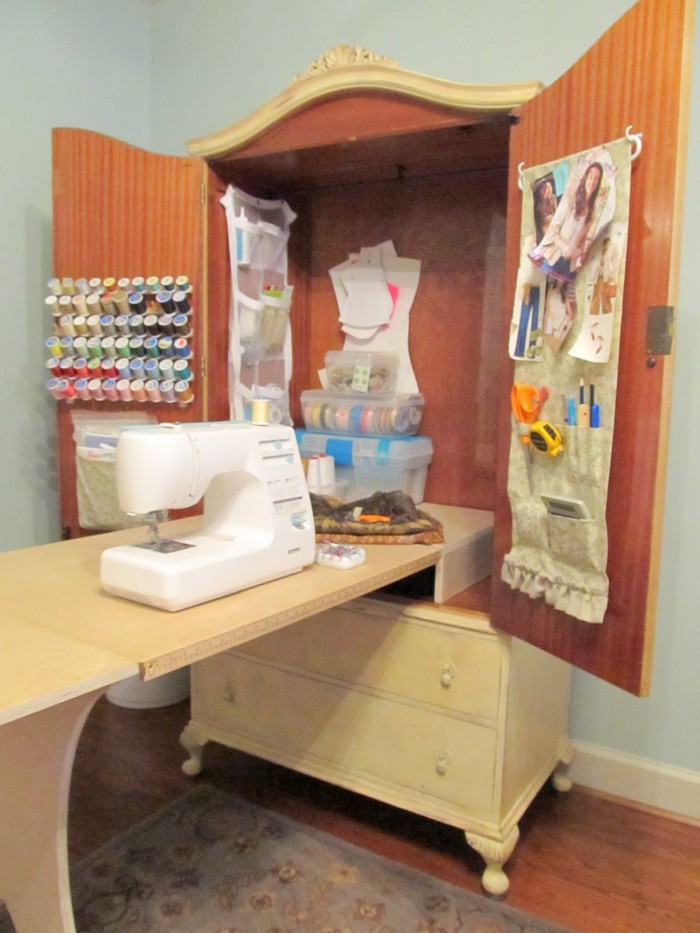
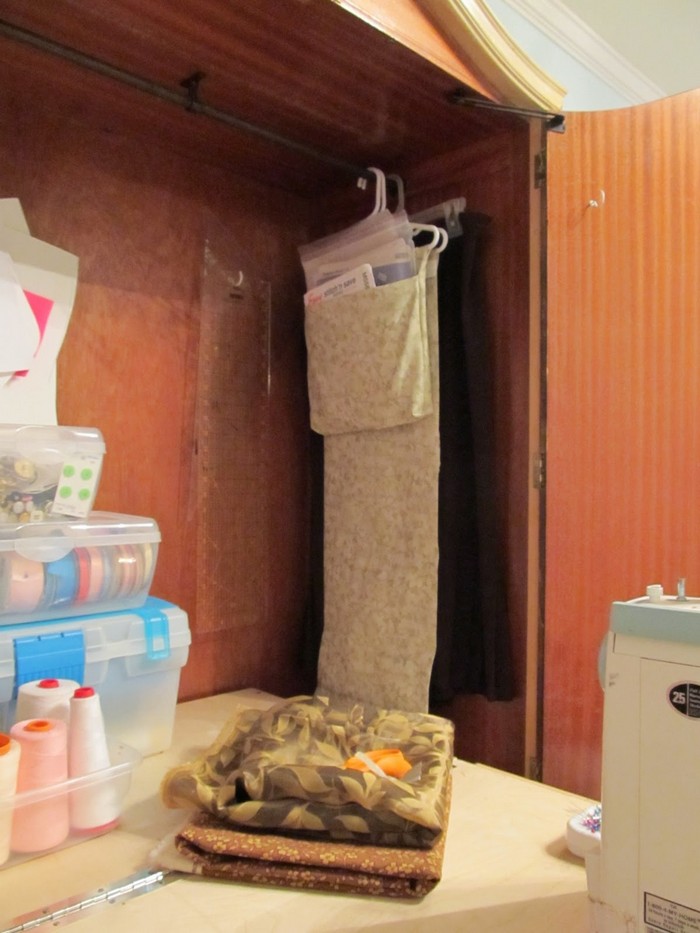
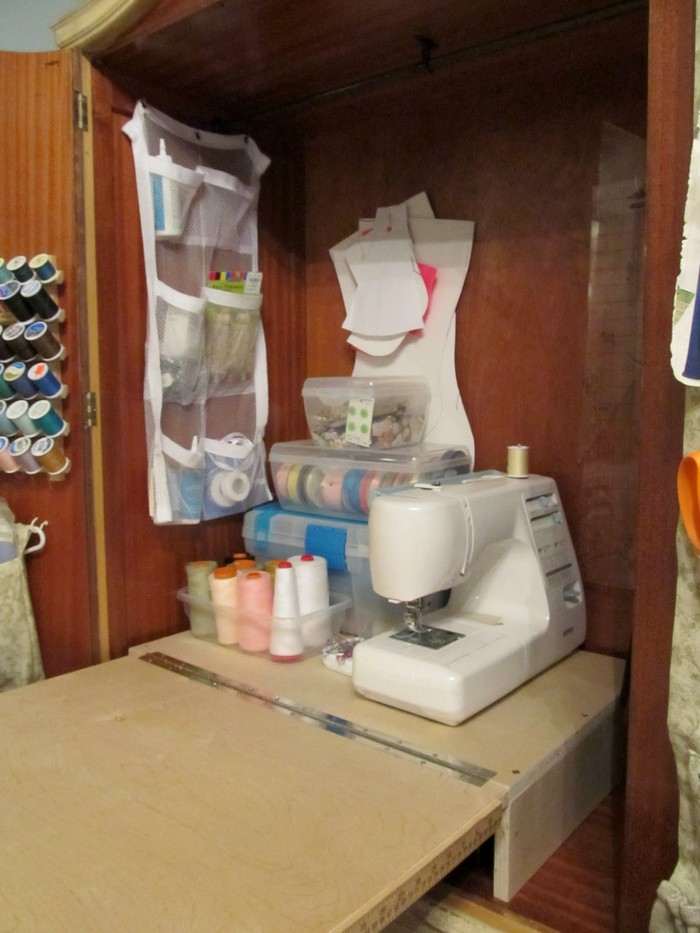

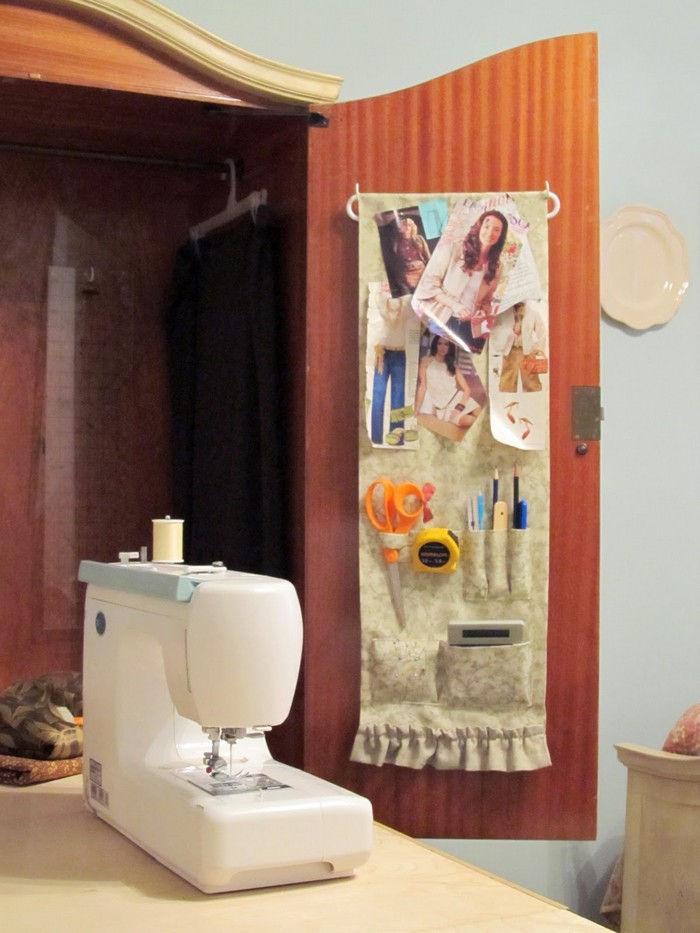
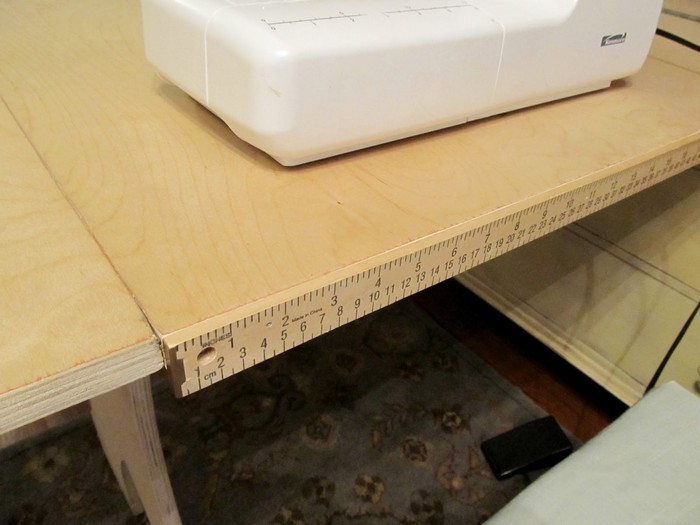
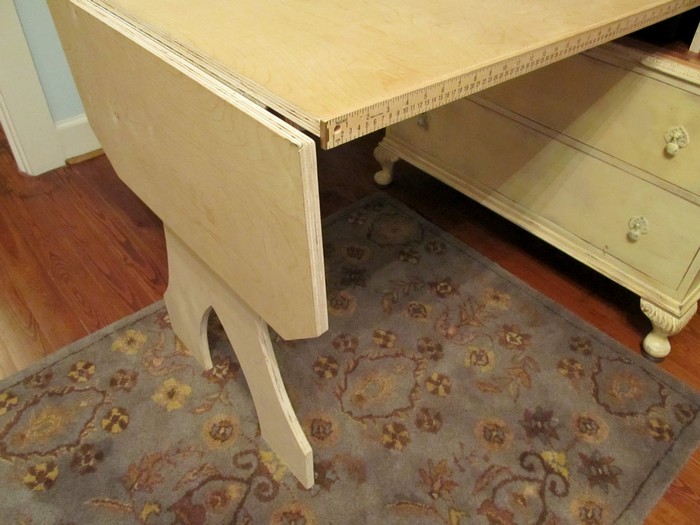

Prioritizing Safety When Building Your French Armoire Sewing Cabinet
Safety is crucial when embarking on any DIY project. Here are some essential safety tips to keep in mind while building the space-efficient DIY French armoire sewing cabinet:
1. Wear Personal Protective Equipment (PPE): Always wear appropriate PPE, including safety glasses or goggles to protect your eyes from flying debris, dust masks to prevent inhalation of sawdust, and gloves to safeguard your hands from sharp edges and splinters.
2. Use Sharp Tools: Ensure all cutting tools, such as saws and utility knives, are sharp and in good working condition. Dull tools can slip or bind, increasing the risk of accidents. Follow proper techniques and guidelines when using cutting tools to prevent injuries.
3. Work in a Well-Ventilated Area: If working indoors, ensure proper ventilation to disperse dust and fumes. Open windows or use fans to improve airflow and reduce exposure to harmful substances from paints, stains, and adhesives.
4. Secure Workpieces: Secure workpieces firmly in place using clamps or a workbench to prevent movement during cutting, drilling, or sanding. This reduces the risk of accidents and ensures more accurate cuts.
5. Follow Electrical Safety Practices: If using power tools, inspect cords for damage before use, and never operate tools with frayed or exposed wires. Use grounded outlets and extension cords rated for outdoor or workshop use. Avoid contact between power tools and water to prevent electrical shocks.
6. Mind Your Surroundings: Keep the workspace clean and organized to prevent tripping hazards. Store tools and materials properly when not in use and keep floors clear of clutter. Be aware of potential hazards such as loose cords, sharp objects, and unstable surfaces.
7. Read Instructions Carefully: Familiarize yourself with the manufacturer’s instructions and safety guidelines for all tools and materials. Follow recommended procedures for assembly, use, and maintenance to minimize risks and ensure safe operation.
8. Take Breaks: Working on DIY projects can be physically and mentally demanding. Take regular breaks to rest, hydrate, and stretch to prevent fatigue and maintain focus.
9. Ask for Assistance When Needed: If a task feels too challenging or unsafe to tackle alone, seek assistance from a friend, family member, or professional. Working collaboratively can make tasks safer and more manageable.
10. First Aid Preparedness: Have a first aid kit readily available in case of minor injuries. Familiarize yourself with basic first aid procedures and know how to address common injuries such as cuts, scrapes, and splinters.
By prioritizing safety and following these tips, you can minimize the risk of accidents and injuries while building your DIY French armoire sewing cabinet. Remember to work carefully, stay focused, and take necessary precautions to ensure a successful and safe project outcome.
Maintaining Your French Armoire Sewing Cabinet
Maintaining your space-efficient DIY French armoire sewing cabinet is essential to ensure its longevity and functionality. Here are some maintenance tips to keep your French armoire sewing cabinet in excellent condition:
1. Regular Cleaning: Dust and clean tour French armoire sewing cabinet regularly to prevent the buildup of dirt and debris. Use a soft cloth or duster to gently remove dust from the surfaces, shelves, and compartments. Avoid using abrasive cleaners or harsh chemicals that could damage the finish.
2. Inspect for Damage: Periodically inspect your French armoire sewing cabinet for any signs of damage, such as loose hinges, cracked wood, or warped surfaces. Address any issues promptly to prevent further damage and maintain the structural integrity of the cabinet.
3. Tighten Hardware: Check the screws, hinges, and other hardware regularly to ensure they are securely fastened. Use a screwdriver or wrench to tighten any loose hardware as needed. Loose hardware can affect the stability and functionality of your French armoire sewing cabinet.
4. Protect from Moisture: Keep your French armoire sewing cabinet away from sources of moisture, such as humid environments or direct exposure to water. Moisture can cause wood to warp, swell, or rot over time. Consider using a dehumidifier or moisture-absorbing products in damp areas to help maintain optimal humidity levels.
5. Avoid Overloading: Be mindful of the weight capacity of your French armoire sewing cabinet and avoid overloading it with heavy items. Excessive weight can strain the shelves, hinges, and other components, leading to damage or failure. Distribute the weight evenly across the shelves and compartments to prevent sagging or bending.
6. Use Care with Sharp Objects: Exercise caution when using sharp objects such as scissors, needles, or rotary cutters near the cabinet. Avoid accidentally scratching or gouging the surfaces, and consider using protective mats or organizers to prevent damage from sharp tools.
7. Protect from Sunlight: Minimize exposure to direct sunlight, as prolonged exposure can cause the wood and finish to fade or discolour over time. Position your French armoire sewing cabinet away from windows or use curtains or blinds to block out sunlight during peak hours.
8. Reapply Finish as Needed: If the finish on your French armoire sewing cabinet begins to show signs of wear or dullness, consider reapplying a protective wood finish or polish to restore its lustre and protection. Follow the manufacturer’s instructions for application and drying times.
9. Organize Contents: Keep the contents of the cabinet organized to prevent clutter and maximize storage space. Use bins, baskets, or drawer organizers to group similar items together and make them easier to find. Regularly declutter and reorganize the cabinet to maintain efficiency and accessibility.
By following these maintenance tips, you can ensure that your space-efficient DIY French armoire sewing cabinet remains in excellent condition for years to come. Regular cleaning, inspections, and care will help preserve its beauty and functionality, allowing you to enjoy your sewing projects with ease.
The Wrap Up
Embarking on the journey to build a space-efficient DIY French armoire sewing cabinet in seven steps opens up a world of creativity and organization for sewing enthusiasts. This project combines functionality with aesthetic appeal, offering a solution to maximize storage while adding a touch of elegance to any sewing space.
Beginning with meticulous planning and measurement, followed by careful assembly and installation, each step contributes to the creation of a customized sewing cabinet tailored to individual needs and preferences. By repurposing a French armoire and incorporating drop leaf table hardware, hooks, and compartments, this DIY project transforms an ordinary piece of furniture into a versatile sewing workstation.
Throughout the process, prioritizing safety ensures a smooth and hazard-free construction experience. Wearing protective gear, using sharp tools, and maintaining a clean and well-ventilated workspace are essential practices to uphold.
As the project nears completion, attention to detail in maintenance and organization guarantees the longevity and functionality of the sewing cabinet. Regular cleaning, inspection for damage, and proper storage of sewing supplies contribute to its upkeep over time.
Ultimately, the space-efficient DIY French armoire sewing cabinet is more than just a piece of furniture; it’s a reflection of passion, creativity, and craftsmanship. By following the seven steps outlined in this guide, sewing enthusiasts can create a workspace that inspires creativity and enhances their sewing experience for years to come.
Frequently Asked Questions
1. What materials do you need to build the French armoire sewing cabinet?
You will need a French armoire as the base, birch plywood for constructing shelves and compartments, piano hinges for attaching the drop leaf table, drop leaf table hardware, hooks for hanging tools and supplies, and wood screws for assembly.
2. Do you need advanced woodworking skills to build the French armoire sewing cabinet?
This project is designed for individuals with basic to moderate woodworking skills. Detailed instructions and step-by-step guidance are provided to help you through the process.
3. How long does it take to complete the French armoire sewing cabinet project?
The time required depends on factors such as skill level, available tools, and the complexity of the design. Generally, it can take a few days to a week to complete the project, including planning, assembly, and finishing touches.
4. Can you customize the design and dimensions of the sewing cabinet?
Yes, the design and dimensions of the sewing cabinet can be customized to fit your specific needs and space requirements. You can adjust the size, layout, and features based on your preferences.
5. Is the French armoire sewing cabinet suitable for beginners?
While some woodworking experience is beneficial, beginners can complete this project with patience and attention to detail. Following the step-by-step instructions and safety guidelines will help ensure a successful outcome.
6. Can you use different types of wood for constructing the shelves and compartments?
Yes, you can use different types of wood for constructing the shelves and compartments, depending on your preference and availability. However, birch plywood is recommended for its strength, stability, and ease of use.
7. How do you secure the sewing machine in the cabinet?
The sewing machine can be secured in the cabinet using straps, Velcro, or custom brackets attached to the underside of the drop leaf table. Ensure that the sewing machine is stable and securely positioned to prevent accidents.
8. What tools do you need for this project?
Basic woodworking tools such as a saw, drill, screwdriver, hammer, measuring tape, and sandpaper are required. Additional tools may include clamps, a level, and a utility knife.
9. Is the sewing cabinet suitable for storing fabric and other sewing supplies?
Yes, the sewing cabinet is designed to provide ample storage space for fabric, thread, notions, and other sewing supplies. You can customize the compartments and shelves to accommodate your specific storage needs.
10. How do you maintain and care for the sewing cabinet?
Regular cleaning, inspection for damage, and tightening of hardware are essential for maintaining the sewing cabinet. Avoid exposure to moisture and direct sunlight, and handle the cabinet with care to ensure its longevity.



